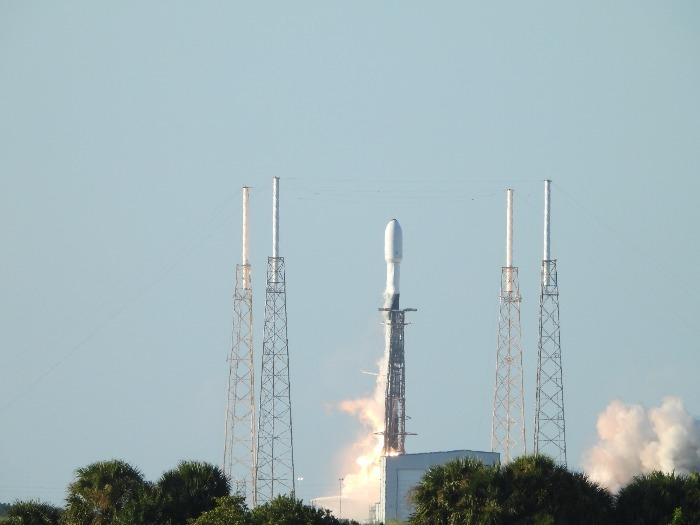S.Korea’s first mission to the Moon, Danuri, enters transfer orbit
The country’s first lunar orbiter launched Thursday as scheduled at 7:08 p.m. EDT from SpaceX’s Falcon 9 rocket
By Aug 05, 2022 (Gmt+09:00)
LG Chem to sell water filter business to Glenwood PE for $692 million


KT&G eyes overseas M&A after rejecting activist fund's offer


Kyobo Life poised to buy Japan’s SBI Group-owned savings bank


StockX in merger talks with Naver’s online reseller Kream


Meritz backs half of ex-manager’s $210 mn hedge fund


South Korea’s first lunar orbiter, Danuri, has been launched onto a ballistic lunar transfer orbit as planned, the country’s science ministry confirmed on Friday afternoon.
The Ministry of Science and ICT confirmed in a press conference the successful entry based on the speed and direction at which the lunar orbiter separated from the projectile it was mounted on.
A transfer orbit is an intermediate elliptical orbit used to move a spacecraft from one orbit to another.
South Korean President Yoon Suk-yeol took to the social media platform Facebook to write, “Danuri is the Republic of Korea’s avant-courier to advance the era of the space economy and its road to becoming a powerhouse of new resources.”
Danuri was launched as scheduled at 7:08 p.m. Eastern Daylight Time (EDT) in the United States or 8:08 a.m. in South Korea on Friday.
Elon Musk-owned SpaceX's Falcon 9 rocket carried Danuri from Cape Canaveral Space Force Station in Florida.
The Korean spacecraft successfully separated from the rocket’s second stage after some 40 minutes of engine firings.
The name Danuri is a portmanteau of the Korean words “dal,” meaning the moon, and “nuri,” meaning rightfully enjoying something.
The orbiter was previously known as the Korea Pathfinder Lunar Orbiter (KPLO).
The Ministry of Science and ICT announced that Danuri made its first-ever communication with the ground station around 9:40 a.m. Korea time, more than an hour and 30 minutes after the launch.
“Danuri has embarked on a full-fledged mission to the Moon with successful communication from the spacecraft to the ground station,” said Lee Jong-ho, the science minister. Lee added that the orbiter still has a long way to go, including its year-long mission to complete on the Moon.

When in lunar orbit, Danuri will join exploration missions by the United States’s National Aeronautics and Space Administration (NASA) India and China.
The South Korean spacecraft is equipped with six scientific instruments – a magnetometer, a gamma-ray spectrometer and three cameras.
Five of the instruments were independently developed by South Korea.
NASA supplied an ultra-sensitive camera called ShadowCam to view the moon’s cold shadowed craters that contain water ice.
A delay/disruption tolerant network (DTN) instrument will be used to test whether an uninterrupted internet connection between Earth and the Moon is possible.
As part of the test, the spacecraft will attempt to send promotional Electronics and Telecommunications Research Institute (ETRI) videos and K-pop megaband BTS' song Dynamite back to Earth.
When it arrives in lunar orbit in mid-December of this year, South Korea will become the seventh entity to successfully send a spacecraft to the Moon.
The United States and the Soviet Union sent robotic spacecraft to the Moon in the 1960s. China, Japan and the European Space Agency launched Moon missions in the following years.
India has sent two orbiters to the Moon as well.
Updated with remarks from President Yoon Suk-yeol and Science and ICT Minister Lee Jong-ho, as well as the ministry’s confirmation of Danuri's successful entry into a transfer orbit.
Write to Hae-Sung Lee at ihs@hankyung.com
Jee Abbey Lee edited this article.
-
 Aerospace & DefenseS.Korean defense firms receive $15 bn order from Poland
Aerospace & DefenseS.Korean defense firms receive $15 bn order from PolandJul 27, 2022 (Gmt+09:00)
2 Min read -
 Korean stock marketS.Korean defense stocks boosted by $7.6 bn deal with Poland
Korean stock marketS.Korean defense stocks boosted by $7.6 bn deal with PolandJul 25, 2022 (Gmt+09:00)
1 Min read


